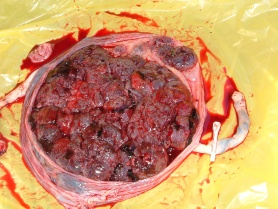 Placenta disposal is a huge problem. Bulky, rather messy with a predictable habit of dripping blood unless packaged properly, and rapidly decaying into a rather unpleasant mush, there seems no end in the inexorable rise in birth rate and thus of placentae needing disposal.
Placenta disposal is a huge problem. Bulky, rather messy with a predictable habit of dripping blood unless packaged properly, and rapidly decaying into a rather unpleasant mush, there seems no end in the inexorable rise in birth rate and thus of placentae needing disposal.
In resource poor counties this can be far more of a problem than here in the UK, though there are always more interesting ways to manage placenta disposal.
If cooking your placenta doesn’t appeal, take it home and bury it under a bush with a touch of some new age.
At one time, the pharmaceutical industries would pay for a chest freezer and periodically collect placentae for processing of hormones that are now produced biosynthetically at the cutting edge of molecular biology. So now there are few real answers that can deal with the vast numbers of placentae to be disposed daily. Resomation is a viable option but has never really caught on.
In the Philippines, innovation has resulted in a busy metropolitan hospital in the Philippines is using a biodigester to generate methane from placentae and food wastes. Novel, practical, and environmentally sound, it may look a bit Heath-Robinson but is none the worse for that.
The biodigester has been constructed at the Perpetual Succor Hospital, in the centre of Cebu City in the Philippines. It generates methane gas from the waste produced by the hospital, including garden and food waste and placentae. The gas produced is then measured, collected, and used to power the hospital in a sustainable and efficient way. Since February, the hospital has been harvesting the methane for cooking, and there are plans to start using it to power the laundry rooms.
Fantastic work, and a great credit to all of those involved, though regrettably if we tried to do the same back here I fear some functionary from the Environment Agency would work diligently to find reasons to prohibit such developments simply because it doesn’t fit the tick box mentality that pervades the regulatory framework dictating clinical and related waste disposal practices.
